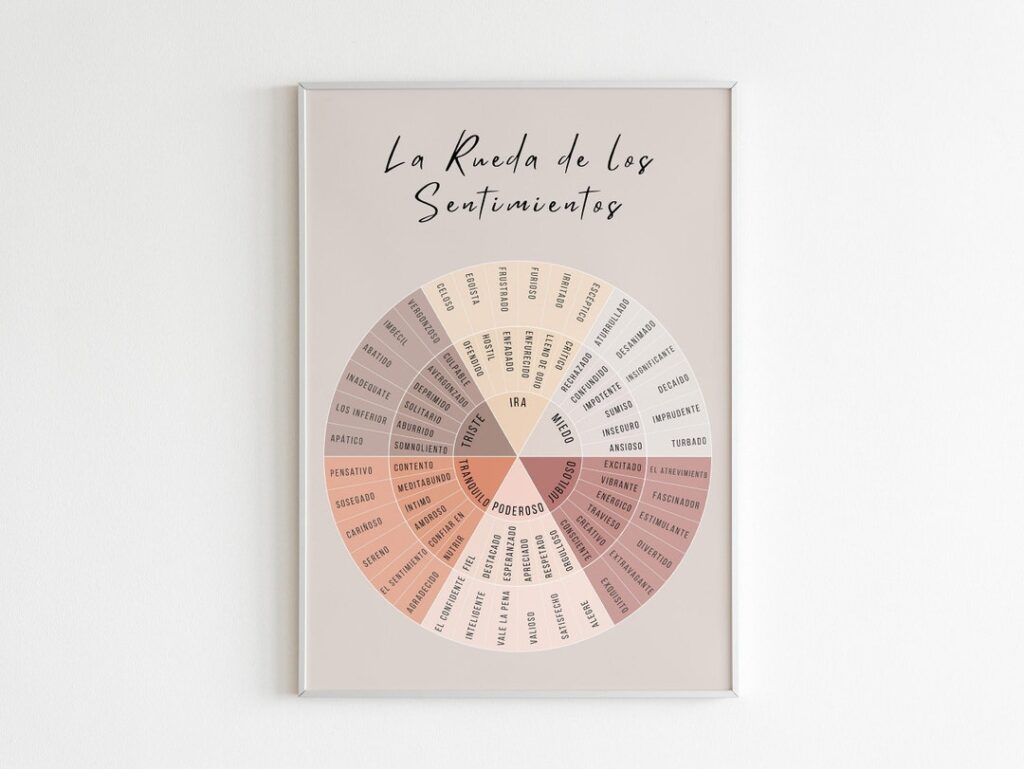
Unlocking Emotions: A Guide to the Feelings Wheel in Spanish PDF
The ability to understand and articulate our emotions is a cornerstone of mental well-being. One powerful tool that aids in this process is the Feelings Wheel. This visual aid helps individuals identify and name their emotions, moving beyond basic labels like “happy” or “sad” to explore a more nuanced range of feelings. For Spanish speakers, accessing a feelings wheel in Spanish PDF format can be particularly beneficial. This article delves into the significance of the Feelings Wheel, its application in Spanish, and how to effectively utilize a feelings wheel in Spanish PDF to enhance emotional literacy.
What is the Feelings Wheel?
The Feelings Wheel, often attributed to Dr. Gloria Willcox, is a circular diagram that categorizes emotions. It typically features a core set of primary emotions at the center, such as joy, sadness, anger, fear, and surprise. Moving outward from the center, the wheel expands into more specific and nuanced feelings related to each primary emotion. For example, under “anger,” one might find feelings like frustration, irritation, or resentment. The outer layers of the wheel provide even more granular descriptions, allowing for a deeper exploration of emotional states.
The primary purpose of the Feelings Wheel is to provide a vocabulary for emotions. Many people struggle to express how they feel because they lack the words to accurately describe their emotional experience. By providing a visual guide and a range of descriptive terms, the Feelings Wheel empowers individuals to better understand and communicate their emotions. A feelings wheel in Spanish PDF serves this purpose specifically for those who are more comfortable or proficient in the Spanish language.
Why Use a Feelings Wheel in Spanish?
For native Spanish speakers or those learning the language, a feelings wheel in Spanish PDF offers several advantages:
- Cultural Relevance: Language and culture are intertwined. Certain emotions may be experienced or expressed differently across cultures. A feelings wheel in Spanish PDF can capture nuances specific to the Spanish-speaking world.
- Accessibility: Language proficiency plays a crucial role in emotional expression. Using a Feelings Wheel in one’s native language ensures a more accurate and comfortable exploration of emotions.
- Therapeutic Benefits: Therapists and counselors working with Spanish-speaking clients can utilize a feelings wheel in Spanish PDF as a valuable tool in sessions. It facilitates communication and helps clients articulate their feelings more effectively.
- Educational Resource: Educators can use a feelings wheel in Spanish PDF to teach children and adolescents about emotional intelligence in a culturally relevant context.
Finding and Using a Feelings Wheel in Spanish PDF
Numerous resources offer feelings wheel in Spanish PDF formats online. A simple search will yield various options, including versions adapted for different age groups and therapeutic approaches. When selecting a feelings wheel in Spanish PDF, consider the following:
- Clarity and Design: The wheel should be visually clear and easy to understand. The font size and layout should be accessible, and the emotion words should be legible.
- Accuracy of Translation: Ensure the Spanish translation is accurate and reflects the intended meaning of the emotions. Ideally, the translation should be reviewed by a native Spanish speaker with expertise in psychology or counseling.
- Relevance to Your Needs: Choose a wheel that aligns with your specific goals. Some wheels are designed for general emotional exploration, while others are tailored for specific populations or therapeutic modalities.
Once you have a feelings wheel in Spanish PDF, here’s how to use it effectively:
- Identify the Primary Emotion: Start by identifying the primary emotion you are feeling (e.g., joy, sadness, anger).
- Explore the Subcategories: Move outward from the center of the wheel to explore the subcategories related to your primary emotion. For example, if you are feeling angry, consider whether you are also feeling frustrated, irritated, or resentful.
- Name Your Emotion: Choose the word that best describes your emotional state. Be as specific as possible.
- Reflect on Your Emotion: Once you have named your emotion, take some time to reflect on it. What triggered this emotion? How is it affecting you? What can you do to manage it effectively?
Benefits of Emotional Literacy
Using a feelings wheel in Spanish PDF or any other tool to enhance emotional literacy can have profound benefits for individuals and communities. Emotional literacy is the ability to understand, express, and manage one’s emotions effectively. It is a crucial component of mental and social well-being.
- Improved Communication: When you can accurately identify and name your emotions, you can communicate your needs and feelings more effectively to others.
- Stronger Relationships: Emotional literacy fosters empathy and understanding in relationships. It allows you to connect with others on a deeper level and build stronger bonds.
- Better Decision-Making: Emotions play a significant role in decision-making. By understanding your emotions, you can make more rational and informed choices.
- Reduced Stress and Anxiety: Emotional literacy helps you manage stress and anxiety by providing you with the tools to regulate your emotional responses.
- Increased Self-Awareness: Exploring your emotions with a feelings wheel in Spanish PDF promotes self-awareness and a deeper understanding of your inner world.
The Feelings Wheel in Therapeutic Settings
Mental health professionals often incorporate the Feelings Wheel into their therapeutic practices. A feelings wheel in Spanish PDF is especially useful when working with Spanish-speaking clients. Here are some ways therapists utilize the Feelings Wheel:
- Emotional Assessment: The Feelings Wheel can be used as an initial assessment tool to help clients identify and articulate their emotional state.
- Therapeutic Dialogue: The wheel serves as a visual aid to facilitate discussions about emotions and explore the underlying causes of emotional distress.
- Cognitive Restructuring: Therapists can use the Feelings Wheel to help clients challenge and reframe negative thought patterns associated with specific emotions.
- Skill-Building: The wheel can be incorporated into skill-building exercises to teach clients how to manage their emotions effectively.
Beyond the PDF: Other Resources for Emotional Learning in Spanish
While a feelings wheel in Spanish PDF is a valuable tool, it’s important to remember that it’s just one resource among many. Other resources that can support emotional learning in Spanish include:
- Books and Articles: Many books and articles on emotional intelligence and mental health are available in Spanish.
- Online Courses and Workshops: Numerous online courses and workshops teach emotional literacy skills in Spanish.
- Support Groups: Support groups provide a safe and supportive environment for individuals to share their experiences and learn from others.
- Therapy: Working with a therapist or counselor who is fluent in Spanish can provide personalized support and guidance in developing emotional literacy skills.
Conclusion: Empowering Emotional Expression with a Feelings Wheel in Spanish
In conclusion, a feelings wheel in Spanish PDF is a powerful tool for enhancing emotional literacy among Spanish speakers. By providing a visual guide and a comprehensive vocabulary for emotions, it empowers individuals to understand, express, and manage their feelings more effectively. Whether used in therapeutic settings, educational programs, or personal exploration, the Feelings Wheel can contribute to improved communication, stronger relationships, better decision-making, and overall well-being. Embracing this resource can unlock a deeper understanding of the emotional landscape and promote a healthier, more fulfilling life. Don’t underestimate the power of having a feelings wheel in Spanish PDF readily available; it can be a significant step towards greater emotional intelligence and self-awareness. [See also: Mindfulness Techniques for Emotional Regulation] [See also: The Importance of Self-Care for Mental Health] [See also: Understanding Anxiety and Depression]

